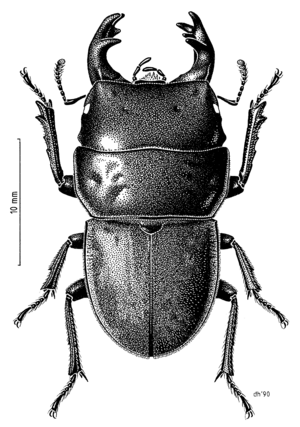Mokohinau stag beetle facts for kids
Quick facts for kids Mokohinau stag beetle |
|
|---|---|
 |
|
| Illustration by Des Helmore | |
| Conservation status | |
 Nationally Critical (NZ TCS) |
|
| Scientific classification | |
| Genus: |
Geodorcus
|
| Species: |
ithaginis
|
| Synonyms | |
|
Lissotes ithaginis Broun, 1893 |
|
The Geodorcus ithaginis, also known as the Mokohinau stag beetle, is a big beetle that cannot fly. It belongs to the stag beetle family, called Lucanidae. This special beetle was first described in 1893 by Thomas Broun. It was found by Andreas Stewart Sandager, a lighthouse keeper on the Mokohinau Islands. Today, this beetle lives on a tiny island called "Stack H". Its home is a small patch of plants, about the size of a living room. This makes the Mokohinau stag beetle in great danger of disappearing forever.
Contents
What the Mokohinau Stag Beetle Looks Like
Male Mokohinau stag beetles are quite large. They can be about 25.5 to 32.8 millimeters (about 1 to 1.3 inches) long. This length includes their big jaws, called mandibles. Males are also about 10.4 to 12.4 millimeters wide.
Female beetles are a bit smaller. They are usually 20.0 to 22.5 millimeters long. Both male and female beetles have a black outer shell, called an exoskeleton. This shell can be dull or a bit shiny.
Special Features of the Beetle
The middle part of their body, called the thorax, is shiny black. It is wider than it is long. The wing covers, known as elytra, are rounded at the back. They are almost as long as they are wide. These covers have short, branched hairs on them.
Male beetles have three teeth on the tips of their mandibles. Females have two teeth. A unique feature of this beetle is a long, cone-shaped tooth. This tooth is found on top of the mandibles in both males and females. This special tooth helps tell them apart from other New Zealand stag beetles.
Where the Mokohinau Stag Beetle Lives
This beetle is only found in the Mokohinau Islands of New Zealand. A lighthouse keeper named Andreas Stewart Sandager found many beetles here. He was stationed on Burgess Island from 1883 to 1889. He collected 130 different beetle species. About a third of these were new to science. Thomas Broun later described them.
Finding the Beetle's Home
The first place this stag beetle was found was called "Halodroma Islet." However, there is no island with that name today. Some people think "Halodroma" might have been another name for Lizard Island. This is a small, flat island southeast of Burgess Island.
After 1902, no more of these beetles were seen for a long time. Then, in 1984, they were found again. They were discovered on "Stack H," a small island about 1.2 hectares (3 acres) in size. This island is southwest of Burgess Island.
Current Location
All recent searches have only found this beetle on Stack H. They live in a small area of New Zealand ice plant, also called horokaka (Disphyma australe). This area is about the size of a living room. The beetle has not been seen on Lizard Island since it was first described in 1893.
The Beetle's Habitat
Most Geodorcus beetles on mainland New Zealand live in rotten logs. But there are no rotten logs on Stack H. The Mokohinau Islands are generally very dry. They do not hold much moisture.
This special beetle digs into a soil layer that feels like peat. This soil is made by the New Zealand ice plant (Disphyma australe). The beetles have also been found under rocks. They live in tussock grass called Chionochloa bromoides. They also live in the fallen leaves under coastal pohutukawa trees.
What the Mokohinau Stag Beetle Eats
These beetles are active at night, which means they are nocturnal. Scientists do not know exactly what adult Mokohinau stag beetles eat. Adult stag beetles around the world usually have mouthparts that help them drink liquids.
For example, another type of stag beetle, Geodorcus helmsi, has been seen drinking sap from tree trunks. Baby stag beetles, called larvae, usually eat rotting wood, tree roots, or rich soil. The Mokohinau stag beetle lives in a place with lots of rich, humus-filled soil. This suggests what their larvae might eat.
Protecting the Mokohinau Stag Beetle
From 1991 to 1994, scientists searched specifically for G. ithaginis. They only found three live beetles on Stack H. The most beetles ever seen at one time recently was nine. The Mokohinau Islands have changed a lot over time. People cleared land, burned areas, and let animals graze. Rats, called kiore or Polynesian rat, were also brought to the islands. Lizard Island even had rats for a short time in the late 1970s.
Threats to the Beetle
Rats were removed from all the Mokohinau Islands in the 1990s. But even after this, searches for G. ithaginis on Lizard Island have not found any. The biggest dangers to this beetle are fires, storms, and rats. Climate change, which could make the island drier, is also a threat.
Because of these dangers, this beetle is listed as 'nationally critical'. This means it is in extreme danger of extinction. Like other Geodorcus species, this large, slow-moving beetle is protected. It is against the law to collect them under the 1953 Wildlife Act.
Future Plans for Conservation
The Department of Conservation had a plan to help this beetle survive. They wanted to breed them in captivity. Then, they would release them onto islands where there are no rats, like Lizard Island.
However, a trip in January 2019 searched the beetle's home on Stack H. They also looked on another nearby stack and Lizard Island. They only found tiny pieces of old beetle shells. This means that the Mokohinau stag beetle might possibly be extinct.
See also
 In Spanish: Geodorcus ithaginis para niños
In Spanish: Geodorcus ithaginis para niños


